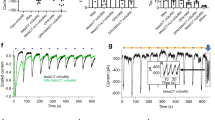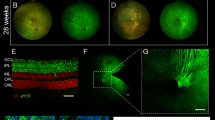Abstract
Several preclinical studies have investigated the potential of algal channelrhodopsin and human melanopsin as optogenetic tools for vision restoration. In the present study, we assessed the potentially deleterious effects of long-term expression of these optogenes on the diseased retina in a large animal model of retinal degeneration, the RPE65-deficient Briard dog model of Leber congenital amaurosis. Intravitreal injection of adeno-associated virus vectors expressing channelrhodopsin and melanopsin had no effect on retinal thickness over a 16-month period post injection. Our data support the safety of the optogenetic approach for the treatment of blindness.
This is a preview of subscription content, access via your institution
Access options
Subscribe to this journal
Receive 12 print issues and online access
$259.00 per year
only $21.58 per issue
Buy this article
- Purchase on Springer Link
- Instant access to full article PDF
Prices may be subject to local taxes which are calculated during checkout



Similar content being viewed by others
References
Sahel J-A, Roska B . Gene therapy for blindness. Annu Rev Neurosci 2013; 36: 467–488.
Strettoi E . A survey of retinal remodeling. Front Cell Neurosci 2015; 9: 494.
Anderson EE, Greferath U, Fletcher EL . Changes in morphology of retinal ganglion cells with eccentricity in retinal degeneration. Cell Tissue Res 2016; 364: 263–271.
O’Brien EE, Greferath U, Fletcher EL . The effect of photoreceptor degeneration on ganglion cell morphology. J Comp Neurol 2014; 522: 1155–1170.
Sengupta A, Chaffiol A, Macé E, Caplette R, Desrosiers M, Lampič M et al. Red-shifted channelrhodopsin stimulation restores light responses in blind mice, macaque retina, and human retina. EMBO Mol Med 2016; 8: 1248–1264.
Doroudchi MM, Greenberg KP, Liu J, Silka KA, Boyden ES, Lockridge JA et al. Virally delivered channelrhodopsin-2 safely and effectively restores visual function in multiple mouse models of blindness. Mol Ther J Am Soc Gene Ther 2011; 19: 1220–1229.
Thyagarajan S, van Wyk M, Lehmann K, Löwel S, Feng G, Wässle H . Visual function in mice with photoreceptor degeneration and transgenic expression of channelrhodopsin 2 in ganglion cells. J Neurosci Off J Soc Neurosci 2010; 30: 8745–8758.
Tomita H, Sugano E, Isago H, Hiroi T, Wang Z, Ohta E et al. Channelrhodopsin-2 gene transduced into retinal ganglion cells restores functional vision in genetically blind rats. Exp Eye Res 2010; 90: 429–436.
Dacey DM, Liao H-W, Peterson BB, Robinson FR, Smith VC, Pokorny J et al. Melanopsin-expressing ganglion cells in primate retina signal colour and irradiance and project to the LGN. Nature 2005; 433: 749–754.
Altimus CM, Güler AD, Villa KL, McNeill DS, Legates TA, Hattar S . Rods-cones and melanopsin detect light and dark to modulate sleep independent of image formation. Proc Natl Acad Sci USA 2008; 105: 19998–20003.
Güler AD, Ecker JL, Lall GS, Haq S, Altimus CM, Liao H-W et al. Melanopsin cells are the principal conduits for rod-cone input to non-image-forming vision. Nature 2008; 453: 102–105.
Hattar S, Liao HW, Takao M, Berson DM, Yau KW . Melanopsin-containing retinal ganglion cells: architecture, projections, and intrinsic photosensitivity. Science 2002; 295: 1065–1070.
Lucas RJ, Hattar S, Takao M, Berson DM, Foster RG, Yau K-W . Diminished pupillary light reflex at high irradiances in melanopsin-knockout mice. Science 2003; 299: 245–247.
Lin B, Koizumi A, Tanaka N, Panda S, Masland RH . Restoration of visual function in retinal degeneration mice by ectopic expression of melanopsin. Proc Natl Acad Sci USA 2008; 105: 16009–16014.
Liu M-M, Dai J-M, Liu W-Y, Zhao C-J, Lin B, Yin Z-Q . Human melanopsin-AAV2/8 transfection to retina transiently restores visual function in rd1 mice. Int J Ophthalmol 2016; 9: 655–661.
Van Wyk M, Pielecka-Fortuna J, Löwel S, Kleinlogel S . Restoring the ON switch in blind retinas: Opto-mGluR6, a next-generation, cell-tailored optogenetic tool. PLoS Biol 2015; 13: e1002143.
Mure LS, Rieux C, Hattar S, Cooper HM . Melanopsin-dependent nonvisual responses: evidence for photopigment bistability in vivo. J Biol Rhythms 2007; 22: 411–424.
Cronin T, Vandenberghe LH, Hantz P, Juttner J, Reimann A, Kacsó A-E et al. Efficient transduction and optogenetic stimulation of retinal bipolar cells by a synthetic adeno-associated virus capsid and promoter. EMBO Mol Med 2014; 6: 1175–1190.
Macé E, Caplette R, Marre O, Sengupta A, Chaffiol A, Barbe P et al. Targeting channelrhodopsin-2 to ON-bipolar cells with vitreally administered AAV restores ON and OFF visual responses in blind mice. Mol Ther J Am Soc Gene Ther 2015; 23: 7–16.
Lagali PS, Balya D, Awatramani GB, Münch TA, Kim DS, Busskamp V et al. Light-activated channels targeted to ON bipolar cells restore visual function in retinal degeneration. Nat Neurosci 2008; 11: 667–675.
Mutter M, Swietek N, Münch TA . Salvaging ruins: reverting blind retinas into functional visual sensors. Methods Mol Biol 2014; 1148: 149–160.
Sugano E, Isago H, Wang Z, Murayama N, Tamai M, Tomita H . Immune responses to adeno-associated virus type 2 encoding channelrhodopsin-2 in a genetically blind rat model for gene therapy. Gene Therapy 2011; 18: 266–274.
Nagel G, Szellas T, Huhn W, Kateriya S, Adeishvili N, Berthold P et al. Channelrhodopsin-2, a directly light-gated cation-selective membrane channel. Proc Natl Acad Sci USA 2003; 100: 13940–13945.
Boulos S, Meloni BP, Arthur PG, Bojarski C, Knuckey NW . Assessment of CMV, RSV and SYN1 promoters and the woodchuck post-transcriptional regulatory element in adenovirus vectors for transgene expression in cortical neuronal cultures. Brain Res 2006; 1102: 27–38.
Narfström K, Wrigstad A, Nilsson SE . The Briard dog: a new animal model of congenital stationary night blindness. Br J Ophthalmol 1989; 73: 750–756.
Bennicelli J, Wright JF, Komaromy A, Jacobs JB, Hauck B, Zelenaia O et al. Reversal of blindness in animal models of leber congenital amaurosis using optimized AAV2-mediated gene transfer. Mol Ther J Am Soc Gene Ther 2008; 16: 458–465.
Tshilenge K-T, Ameline B, Weber M, Mendes-Madeira A, Nedellec S, Biget M et al. Vitrectomy before intravitreal injection of AAV2/2 vector promotes efficient transduction of retinal ganglion cells in dogs and nonhuman primates. Hum Gene Ther Methods 2016; 27: 122–134.
Ivanova E, Pan Z-H . Evaluation of the adeno-associated virus mediated long-term expression of channelrhodopsin-2 in the mouse retina. Mol Vis 2009; 15: 1680–1689.
Wietek J, Prigge M . Enhancing channelrhodopsins: an overview. Methods Mol Biol 2016; 1408: 141–165.
Rabinowitz JE, Rolling F, Li C, Conrath H, Xiao W, Xiao X et al. Cross-packaging of a single adeno-associated virus (AAV) type 2 vector genome into multiple AAV serotypes enables transduction with broad specificity. J Virol 2002; 76: 791–801.
Petit L, Lhériteau E, Weber M, Le Meur G, Deschamps J-Y, Provost N et al. Restoration of vision in the pde6β-deficient dog, a large animal model of rod-cone dystrophy. Mol Ther J Am Soc Gene Ther 2012; 20: 2019–2030.
Acknowledgements
We thank the Vector Core Facility for producing the rAAV vectors and the staff of the Boisbonne Center for animal care. We also thank Philippe Hulin and Steven Nedellec (Cellular and Tissular Imaging Core Facility, INSERM, Nantes, France) for their technical assistance. This work was supported by unrestricted grants from the Association Française Contre les Myopathies, INSERM, the Fondation Pour la Thérapie Génique en Pays de la Loire and the Region Pays de la Loire. SP was supported for this work by the Institut National de la Santé et de la Recherche Médicale (INSERM), Pierre et Marie Curie University (UPMC), the Centre National de la Recherche Scientifique (CNRS), FRM (Fondation pour la Recherche Médicale), the E-Rare Project (OPTOREMODE), the Foundation Fighting Blindness (Wynn-Gund translational research award), the French State program ‘Investissements d'Avenir’ managed by the Agence Nationale de la Recherche (LIFESENSES: ANR-10-LABX-65) and by the French Agence National pour la Recherche (ANR) as part of the second Investissements d’Avenir program (ANR-15-RHUS-0001).
Author information
Authors and Affiliations
Corresponding author
Ethics declarations
Competing interests
Serge Picaud is a stakeholder in the company Gensight Biologics. All other co-authors declare no conflict of interest.
Additional information
Supplementary Information accompanies this paper on Gene Therapy website
Supplementary information
Rights and permissions
About this article
Cite this article
Ameline, B., Tshilenge, KT., Weber, M. et al. Long-term expression of melanopsin and channelrhodopsin causes no gross alterations in the dystrophic dog retina. Gene Ther 24, 735–741 (2017). https://doi.org/10.1038/gt.2017.63
Received:
Revised:
Accepted:
Published:
Issue Date:
DOI: https://doi.org/10.1038/gt.2017.63
This article is cited by
-
A 2020 vision of ocular gene therapy
Gene Therapy (2021)



